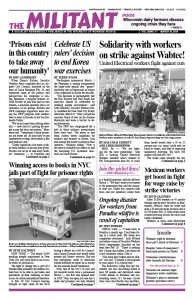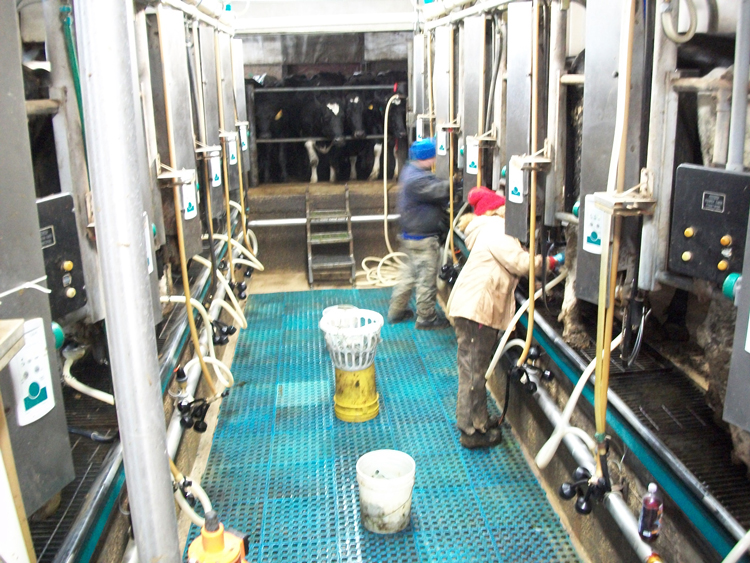MUSCODA, Wis. — In the past year dairy farmers in Wisconsin have had to shut down 714 farms. That’s 8.2 percent, dropping the total number of dairy farms here to 8,046. That is roughly half the number of 16 years ago.
It’s the smaller, family farms, that are being forced out. While the number of dairy cows has remained the same, the average number of cows per farm has doubled. The number of larger farms, known as CAFOs — Concentrated Feeding Operations, farms with over 700 cows — has risen to 272, an increase of almost 550 percent since 2000. The average farm has 155.
I visited four dairy farmers in the Muscoda-Richland area of Wisconsin at their farms Feb. 21 with Randy Jasper, a former dairy farmer who now runs a farm equipment repair shop there, and Dean Hazlewood, another Socialist Workers Party member from Chicago. The farmers all said they’re caught between rising production costs and lower prices for their milk today.
Kenneth and Starlyn Miller, who own a dairy with 133 milking cows, invited us into their kitchen for a discussion. “We paid off our debt a few years ago. But now we have debt again,” Kenneth Miller said. “Everyone tells us that we have to produce more milk to stay in business. But the government says there’s too much milk on the market. How can there be too much milk? There are millions of people who go hungry.”
In 1933, the average Wisconsin cow produced 5,140 pounds of milk per year, according to the U.S. Department of Agriculture. By 1978, that had more than doubled to 11,735 pounds. And in 2017, it had doubled again to 23,725 pounds — soaring nearly 23 percent in just the last decade.
Is there too much milk?
The so-called glut of milk on the U.S. market — milk working people worldwide would love to get their hands on — drives down the price dairy farmers receive on the market. “I get $13.75 per hundredweight,” Kenneth Miller said. U.S. government agencies report that for the past four years the price farmers have gotten has been below $21, which was the average break-even price in 2017.
“To help make ends meet, I used to sell 12 to 15 cows for meat at $1 a pound around harvest time. Now I don’t get enough to make it worthwhile because of cow auctions, where the packing companies buy up cows sold by farmers who are shutting down,” he said. “I just sold an older cow for 20 cents a pound. If you go to the store you pay $3 a pound for ground beef!”
Farmers’ costs are up. “It costs $150 for a vet just to come to your door,” said Starlyn Miller. The price of hay has gone up since the drought of 2012.
They used to rent additional farmland to grow crops for feed and for sale. “But land rents are just too high,” Kenneth Miller said.
And dairy farmers don’t get any help from government payouts to provide relief from the effects of international tariff battles today. We asked about the impact of the tariffs on exports of farm products. “It doesn’t pay to apply for government relief for tariff losses,” he said. “We get only one penny a bushel for corn losses.” The market price for corn is $3.66 per bushel.
The Wisconsin Farmers Union reports that a 55-cow dairy farm would receive a one-time government payment of $725 from the bailout, but stood to lose between $36,000 and $48,000 in income last year from low milk prices.
“I think about selling out,” said Kenneth Miller with a smile. “There are only two reasons to keep going. First, I don’t know if I would like factory work. And second, I’m hoping for a miracle.”
“It used to be that after a couple of bad years, we’d have a good one that made up the difference, and then a few years when we could do OK. Where are the good years now?” he asked.
After our discussion, the Millers signed up for a 12-week introductory subscription to the Militant and bought a copy of In Defense of the US Working Class, by Mary-Alice Waters.
‘I love milking’
“We’re surviving, but it’s hard work,” said Steve Armbruster, who runs a 300-cow dairy with his two brothers. “It takes me six to seven hours to milk the herd,” he said. “I get up, milk them, try to get three hours of sleep, and then milk them again.”
“We watch where every dollar goes,” Armbruster said. “I can’t imagine doing anything else. I love milking.”
“There’s a lot of hidden expenses most people don’t think about,” he said. “For instance, it takes two years for a heifer to grow into a milking cow. All that time, you have to feed them, take care of their health and medical expenses, and pay for their overhead expenses.”
Steve Schmitz, who has been dairying since 1974, has a herd of 135 cows.
“Nobody in the government looks out for farmers. All they care about is how the big corporations are doing,” Schmitz told us. He has had success crossbreeding Holsteins, the traditional milking cow in Wisconsin, with Montbeliarde cattle. The milk fetches a higher price because it is higher in milk fats.
“It seems like workers and farmers are facing more and more problems surviving,” he said. Schmitz signed up for a subscription to the Militant and bought a copy of In Defense of the US Working Class for his wife, who used to be a teacher and has been following the teachers strikes that began in West Virginia a year ago.
Workers and family farmers both face exploitation by capital and the social class that wields it. Building an alliance between workers and farmers to fight that exploitation is crucial.


